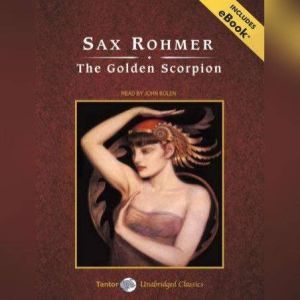

The Golden Scorpion, with eBook
Author: Sax Rohmer
Narrator: John Bolen
Unabridged: 7 hr 46 min
Format: Digital Audiobook Download
Publisher: Tantor Media
Published: 08/17/2009
Includes:
Bonus Material
![]()


Author: Sax Rohmer
Narrator: John Bolen
Unabridged: 7 hr 46 min
Format: Digital Audiobook Download
Publisher: Tantor Media
Published: 08/17/2009
Includes:
Bonus Material
![]()
Sax Rohmer was a prolific English mystery writer who was best known for creating the master criminal Dr. Fu-Manchu. The golden age of Fu-Manchu stories and the peak of Rohmer's career was in the 1930s. Sinister, Oriental Fu-Manchu stereotypes, which were feared since the turn of the century, appeared frequently in popular fiction at that time. Among the best-known doppelgangers is the title character from Ian Fleming's James Bond novel Dr. No.
Sax Rohmer was born Arthur Henry Ward in 1883 in Birmingham, England, to Irish parents. He received no formal schooling until he was about ten years old. Rohmer, impressed by his mother's claims that he was a descendent of the famous seventeenth-century Irish general Patrick Sarsfield, adopted the name Sarsfield. His pen name came from sax which was Saxon for "blade" and rohmer which meant "roamer." Rohmer worked in odd jobs before starting his writing career at age twenty. In 1909 he married Rose Knox, who was purportedly psychic.
In addition to stories and serials, Rohmer wrote comedy sketches for entertainers. His first Fu-Manchu novel, The Mystery of Dr. Fu-Manchu, was written in 1913 and gained immediate success. In 1915 Rohmer invented his detective character Gaston Max, who first appeared in The Yellow Claw. From the 1920s through the 1930s, Rohmer was one of the most widely read and highly paid magazine writers in the English language. Success brought Rohmer temporary financial security, and he traveled to the Near East, Jamaica, and Egypt. But he lost most of his fortune while gambling in Monte Carlo. After World War II, the Rohmers moved back to the United States and ultimately settled in White Plains, New York. Sax died from a combination of pneumonia and a stroke on June 1, 1959.
Nice early Pulp era adventure/mystery read. Recommended......more
An old mystery novel that is certainly the product of it's time. Unfortunately, that includes a fair bit of racism in the story (despite the fact even the characters refute that this is a "Yellow Peril" story). If can get past the old writing style and all that comes with it, it isn't a bad read. My......more
The Golden Scorpion by Sax Rohmer is one of many "Yellow Peril"-type adventure/mystery stories from the early 20th Century. Trading heavily on Western fears and the "mysteries of the Orient," super-villains from the East like Rohmer's Dr. Fu Manchu and the titular Scorpion of this story were present......more
It's a shame that people get hung up on the racism in this book as it's a thumping good read. Guys you need to remember that this is of its time and therefore will use language and mores of its time. If you take that into consideration there are some really high-concept ideas in there and the Gaston......more
This book is not only a sequel to "The Yellow Claw" featuring again French detective Gaston Max and Inspector Dunbar of Scotland Yard, but also fits into the Fu Manchu sequence between "The Hand of Fu Manchu" and "The daughter of Fu Manchu" Fu Manchu himself briefly appears but is unnamed. One of Ro......more